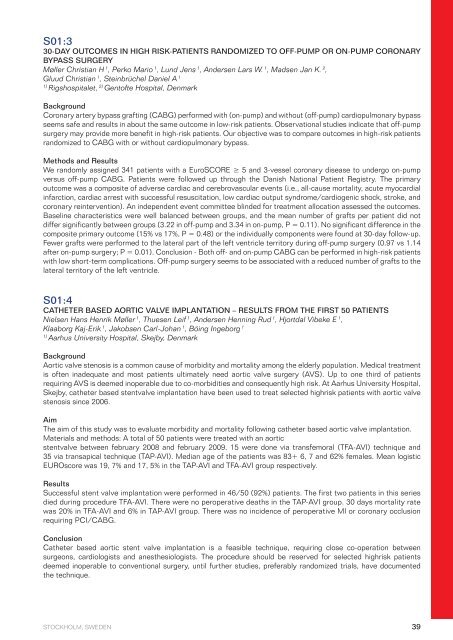SATS 2009 Final Program - Scandinavian Association for Thoracic ...
SATS 2009 Final Program - Scandinavian Association for Thoracic ...
SATS 2009 Final Program - Scandinavian Association for Thoracic ...
You also want an ePaper? Increase the reach of your titles
YUMPU automatically turns print PDFs into web optimized ePapers that Google loves.
S01:3<br />
30-DAY OUTCOMES IN HIGH RISK-PATIENTS RANDOMIZED TO OFF-PUMP OR ON-PUMP CORONARY<br />
BYPASS SURGERY<br />
Møller Christian H 1 , Perko Mario 1 , Lund Jens 1 , Andersen Lars W. 1 , Madsen Jan K. 2 ,<br />
Gluud Christian 1 , Steinbrüchel Daniel A 1<br />
1) Rigshospitalet, 2) Gentofte Hospital, Denmark<br />
Background<br />
Coronary artery bypass grafting (CABG) per<strong>for</strong>med with (on-pump) and without (off-pump) cardiopulmonary bypass<br />
seems safe and results in about the same outcome in low-risk patients. Observational studies indicate that off-pump<br />
surgery may provide more benefit in high-risk patients. Our objective was to compare outcomes in high-risk patients<br />
randomized to CABG with or without cardiopulmonary bypass.<br />
Methods and Results<br />
We randomly assigned 341 patients with a EuroSCORE ≥ 5 and 3-vessel coronary disease to undergo on-pump<br />
versus off-pump CABG. Patients were followed up through the Danish National Patient Registry. The primary<br />
outcome was a composite of adverse cardiac and cerebrovascular events (i.e., all-cause mortality, acute myocardial<br />
infarction, cardiac arrest with successful resuscitation, low cardiac output syndrome/cardiogenic shock, stroke, and<br />
coronary reintervention). An independent event committee blinded <strong>for</strong> treatment allocation assessed the outcomes.<br />
Baseline characteristics were well balanced between groups, and the mean number of grafts per patient did not<br />
differ significantly between groups (3.22 in off-pump and 3.34 in on-pump, P = 0.11). No significant difference in the<br />
composite primary outcome (15% vs 17%, P = 0.48) or the individually components were found at 30-day follow-up.<br />
Fewer grafts were per<strong>for</strong>med to the lateral part of the left ventricle territory during off-pump surgery (0.97 vs 1.14<br />
after on-pump surgery; P = 0.01). Conclusion - Both off- and on-pump CABG can be per<strong>for</strong>med in high-risk patients<br />
with low short-term complications. Off-pump surgery seems to be associated with a reduced number of grafts to the<br />
lateral territory of the left ventricle.<br />
S01:4<br />
CATHETER BASED AORTIC VALVE IMPLANTATION – RESULTS FROM THE FIRST 50 PATIENTS<br />
Nielsen Hans Henrik Møller 1 , Thuesen Leif 1 , Andersen Henning Rud 1 , Hjortdal Vibeke E 1 ,<br />
Klaaborg Kaj-Erik 1 , Jakobsen Carl-Johan 1 , Böing Ingeborg 1<br />
1) Aarhus University Hospital, Skejby, Denmark<br />
Background<br />
Aortic valve stenosis is a common cause of morbidity and mortality among the elderly population. Medical treatment<br />
is often inadequate and most patients ultimately need aortic valve surgery (AVS). Up to one third of patients<br />
requiring AVS is deemed inoperable due to co-morbidities and consequently high risk. At Aarhus University Hospital,<br />
Skejby, catheter based stentvalve implantation have been used to treat selected highrisk patients with aortic valve<br />
stenosis since 2006.<br />
Aim<br />
The aim of this study was to evaluate morbidity and mortality following catheter based aortic valve implantation.<br />
Materials and methods: A total of 50 patients were treated with an aortic<br />
stentvalve between february 2008 and february <strong>2009</strong>. 15 were done via transfemoral (TFA-AVI) technique and<br />
35 via transapical technique (TAP-AVI). Median age of the patients was 83+ 6, 7 and 62% females. Mean logistic<br />
EUROscore was 19, 7% and 17, 5% in the TAP-AVI and TFA-AVI group respectively.<br />
Results<br />
Successful stent valve implantation were per<strong>for</strong>med in 46/50 (92%) patients. The first two patients in this series<br />
died during procedure TFA-AVI. There were no peroperative deaths in the TAP-AVI group. 30 days mortality rate<br />
was 20% in TFA-AVI and 6% in TAP-AVI group. There was no incidence of peroperative MI or coronary occlusion<br />
requiring PCI/CABG.<br />
Conclusion<br />
Catheter based aortic stent valve implantation is a feasible technique, requiring close co-operation between<br />
surgeons, cardiologists and anesthesiologists. The procedure should be reserved <strong>for</strong> selected highrisk patients<br />
deemed inoperable to conventional surgery, until further studies, preferably randomized trials, have documented<br />
the technique.<br />
STOCKHOLM, SWEDEN 39


